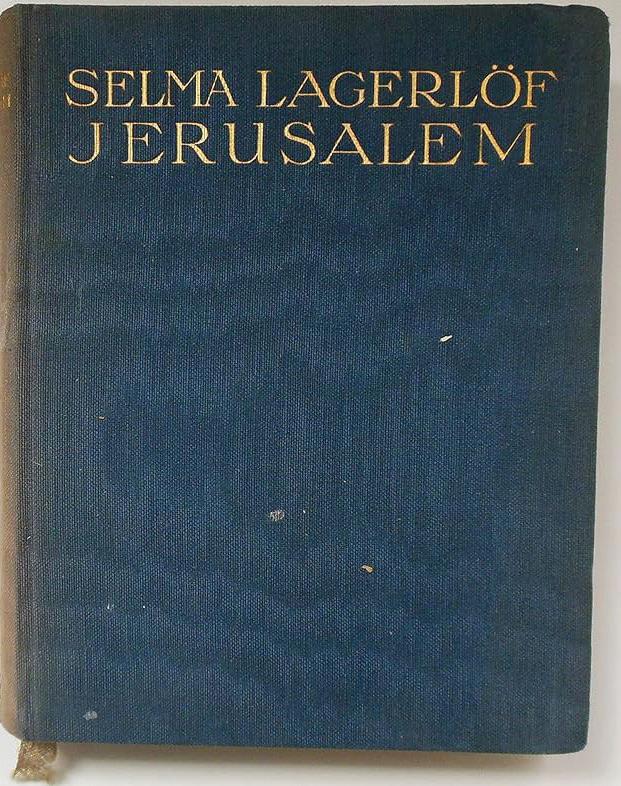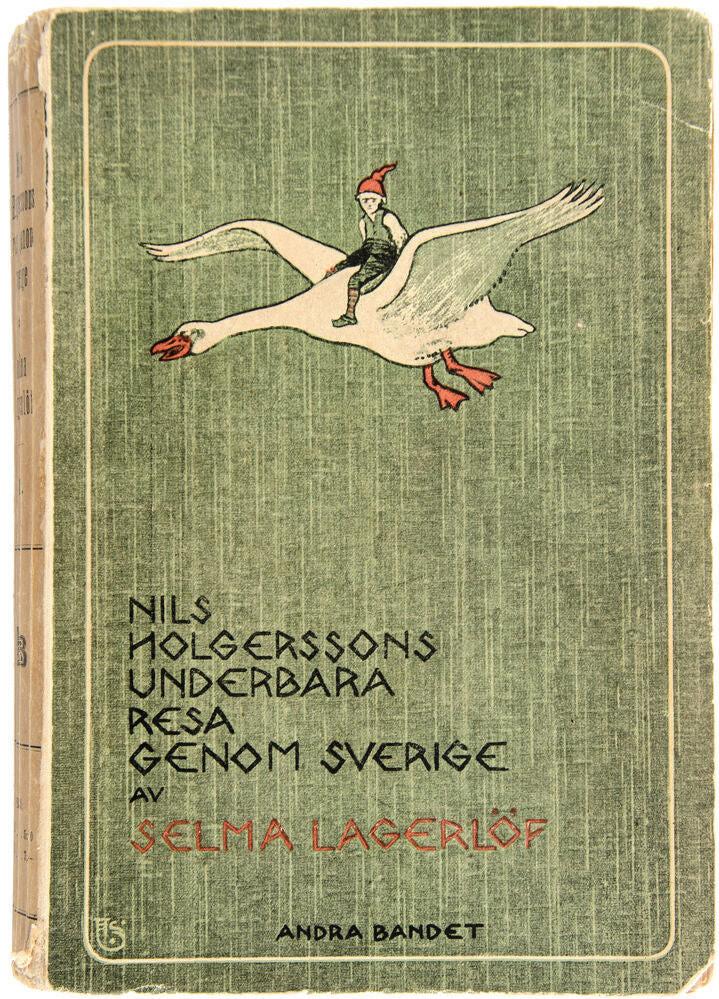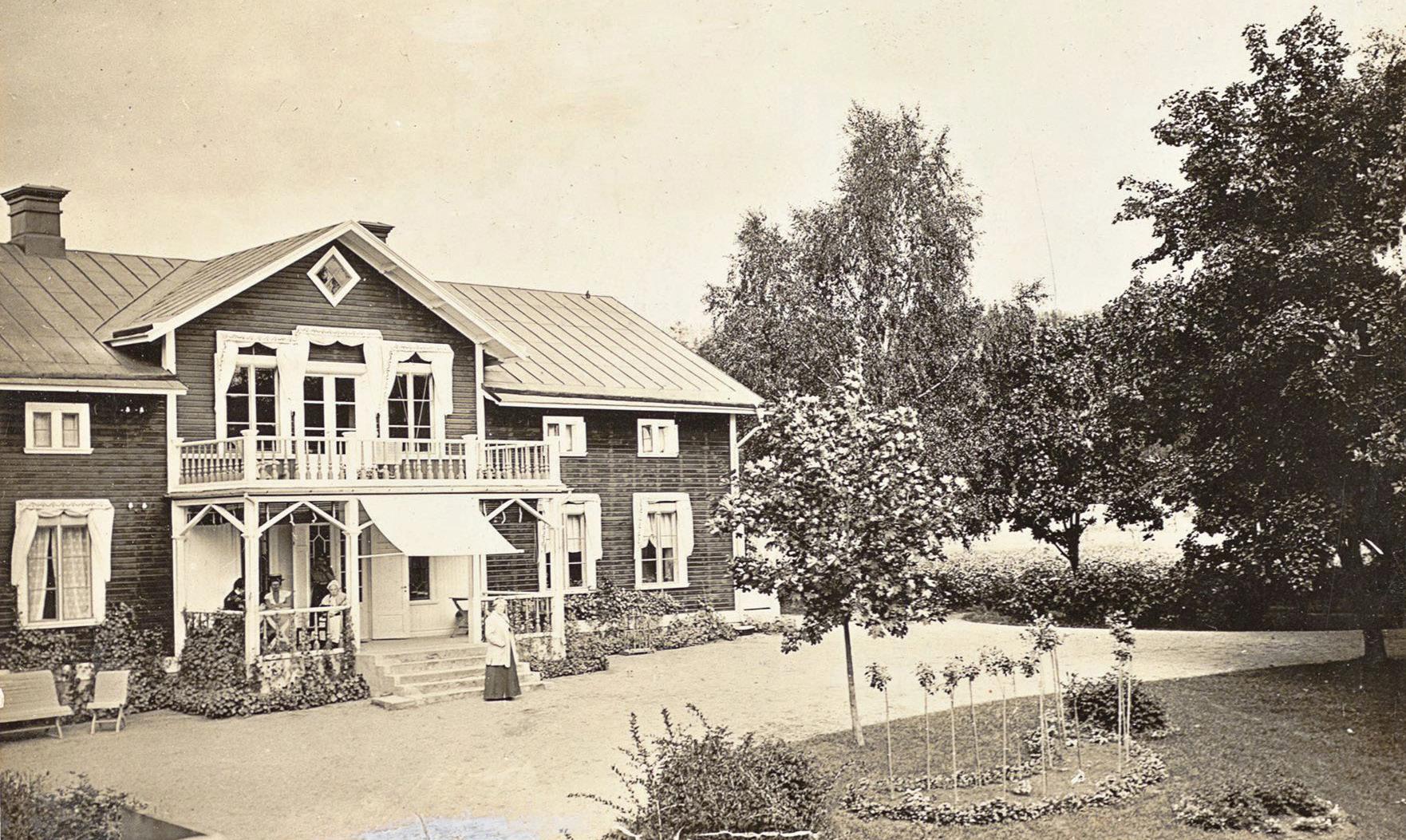




Selma Lagerlöf was the first woman and the first Swede to be awarded the Nobel Prize in literature. Her home Mårbacka, and the old tales of Värmland, were central sources of inspiration for her literary canon and unique style.
By Noelle Norman
In the far west of Värmland, near the border with Norway, a young girl awakes. She is almost four years old. She tries to get up but cannot move her legs. Selma has suddenly become paralyzed. A year later, she still can't walk, but must be carried everywhere. The family travels to the west coast of Sweden to see if healing baths can help her. Rumor has it there is a bird from paradise aboard one of the boats in the harbor. They go to see it. Selma is lifted onto deck. When she sees the bird, she climbs up on a table and stands beside it. It is truly like in paradise, but even more beautiful, she thinks. Then she hears someone shouting and realizes that she has walked. The family thinks it's the invigorating baths and the fresh air of the west coast that has made her well, but in her heart, Selma knows it was the bird. She has magical thoughts. And when she comes home to Mårbacka again, she sees everything in a new light – the house, the animals, the farm, the trees, the family. They are etched into her. She has become “one who sees”, and is convinced that she has unique powers, a unique ability, something that no one else has.
With its vast lakes and forests, the province of Värmland is distant and isolated from Europe’s cultural centers. The art of storytelling is kept alive in the small manor houses. Landowners are conscious of their rank and

their responsibility to culture, but socially and economically they are close to the farmers, and the traditions and legends of the masses penetrate their drawing rooms. The epic and folkloristic tradition is carried on by women and this is also the case at Mårbacka, Selma Lagerlöf’s home. At night, her family gathers to tell stories of ghosts, forest beings, of what lies beyond the visible.
“I live in such a remarkable world. In the evenings, when I sit alone and all is quiet, I feel as though only a small, thin veil prevents me from experiencing superhuman things,” writes Selma.
Selma’s father, Lieutenant Lagerlöf, is known for his grand parties. He dreams that one day, the king will stop by on one of his many trips to and from Norway. The Lagerlöf family belongs to a well-known lineage of priests, farmers, mill owners, influential people. But a new era is dawning. The old estates are no longer lucrative. Money is pouring out of Mårbacka. The adults are worried. Selma feels it. Lieutenant Lagerlöf’s dreams
of expanding Mårbacka are stalled and his parties soon fall silent.
In Europe, there are calls for women's liberation. The first battle concerns the right to an education. In the Lagerlöf family, it's the sons who get to study. Selma stays home on the farm with her sisters. She suffers from hip pain and limps. At the age of 14, she goes to stay with relatives in Stockholm so that she can attend an orthopedic clinic. They take her along to plays and concerts, exposing her to a new world of culture and the arts.
When Selma returns to Värmland, the world feels closed off. The girls stay on the farm, waiting to be married off. Her beloved older sister Anna is married and has a daughter, but
they both contract tuberculosis and die when Anna is only 22 years old. If even strong Anna can’t make it, what will happen to her? She concludes she must leave, and secretly applies to the Royal Women’s Teaching Academy in Stockholm. It is the only higher education available to women in Sweden. In the autumn of 1882, she passes the training college’s entrance exam, but her father says no and orders her to come home. At this time, women don’t reach the age of majority until they turn 25, if they are still unmarried. But Selma still chooses to defy her father. Her brother Johan lends her money so that she can start studying. Selma is 26 years old when she obtains her teaching degree. She finds work in the small town of Landskrona in Skåne. The same summer, her father dies. The debts he leaves behind are greater than anyone has realized. Selma’s brother Johan tries to keep the farm going but fails. Mårbacka goes bankrupt, and the household goods are sold at auction in June 1888. The family disperses, leaving Värmland behind. Selma’s mother and unmarried aunt Louise move in with Selma in her small, rented room in Landskrona. Johan travels to America in search of a future. His wife and two children remain in Sweden.
However, Landskrona is not as isolated as it seems. It’s close to Copenhagen, where Selma spends a great deal of time, making valuable acquaintances in intellectual circles. It acts as an awakening. She writes and writes. But although she has left Värmland, in her writings, the province is ever-present. The forests, lakes, people, and stories of the olden days grow and take shape inside of her.
She submits a few chapters of what will become “Gösta Berling’s Saga” to

a competition and wins first prize. Her contribution attracts enormous attention in literary Sweden. It’s considered sensational. She works day and night to finish the novel.
“My brain is as tender as a sick tooth, aches at the slightest touch of anything foreign. The thing is, I’m about to finish the novel and my fantasy cells are so active that in everything else I am a complete idiot,” Selma writes in a letter.
“Gösta Berling’s Saga” is a great novel about old Värmland. About the farms, the people, and the wild parties. It’s a strange concoction of good and evil that arouses sensation but also perplexes. Fairy tale and magic play a part in the story about the defrocked priest Gösta Berling and the other “cavaliers” of Ekeby, who take over the manor and drive it to its doom – and its resurrection. Selma has created a new literary style: a lyrical prose of sorts, mixed with lucid and fast-paced passages.
The cultural elite of the time, Albert Engström, Gustaf Fröding, and
Verner von Heidenstam, are perplexed: this new voice, this new literary style with its return to nature, to romanticism, is what they have been searching for and trying to achieve themselves. And here’s this little schoolmistress, instinctively mastering what has remained beyond their reach.
Selma receives a significant scholarship from the Swedish Academy. She sends money to Johan, her brother who helped her when nobody else would and who now lives in poverty in Chicago. She also buys tickets for his wife and children so that they can join him in America.
The rest, Selma spends on an incredible journey. Her friend and lover, author Sophie Elkan, has found an article in a newspaper about something that interests Selma. In 1896, 37 farmers from the small village of Nås in Dalarna sold everything they owned to emigrate to the Holy Land of Jerusalem. Selma wants to meet them and find out how their ideas of Palestine and Jerusalem compare to reality. In December of 1899, she and Sophie take the train to Brindisi and cross the Mediterranean to Egypt and Cairo. They travel by boat on the Nile and continue on camelback. The expedition causes a stir in the media; two solo female authors embarking on an adventure of this kind.
In March of the new century, they finally arrive in Jerusalem, the holy city of three religions. They find the Swedish farmers who have moved in with a Christian sect – the American colony – where they await the return of Christ. Selma visits the colony every day for two weeks to interview the immigrants living there in celibacy. Marriages have been broken up. Medicine is forbidden. Many have

already died. The Christ that the farmers see in their feverish dreams does not come. The experience affects Selma deeply.
“The city is hot with religion,” she writes. Sophie, who has a Jewish background, is also appalled.
“Truly, it is a dreadful city like none I have ever seen,” writes Sophie. “A city of fanaticism, intolerance, and beautiful childhood memories.”
The novel “Jerusalem” becomes Selma’s major international breakthrough. It is released in two parts. The first part depicts the lives of the farmers in Sweden before emigrating and the second part their life in Jerusalem. All major authorities are questioned: God, the priest, and the landowner. If one can’t believe in any of them, who can one trust to provide guidance in life?
Now that Selma can support herself as a writer, she resigns from her job as a teacher and moves to Falun to be close to her sister Gärda, their



mother and old aunt.
Dalarna has become the place where the new, national romantic image of Sweden is being forged by artists like Carl Larsson and Anders Zorn, among others. Selma spends time in their circles. In Dalarna she also meets and falls in love with
Valborg Olander, who is a teacher and women’s rights advocate. Valborg convinces Selma to write a textbook for all of Sweden’s school children; a book that will unite Sweden. Selma reluctantly agrees and begins working on “The Wonderful Adventures of Nils”. At the start of the novel, Nils

Holgersson is a mean and unreliable teenager. As punishment, he is transformed into a tiny elf. In this miniature format, he is dragged along by the young gander Mårten on a goose migration bound for the north. Together, they travel all over Sweden, learning about its geography, history, and mythology in the process. Nils is put through a number of tests that teach him how camaraderie and solidarity are necessary for his survival and ability to eventually find his way back home. “The Wonderful Adventures of Nils” becomes a bestseller, and in 1907, Selma uses the proceeds from the book to buy back her childhood home of Mårbacka.
In the early 1900s, Selma Lagerlöf also becomes an important figure in the new art form of film. Many want to adapt her stories into screenplays. Greta Garbo has her breakthrough in the filmed version of “Gösta Berling’s Saga”.
Selma becomes the first Swedish woman to receive the title of honor-
ary doctorate at Uppsala University. In 1909, she becomes the first woman and the first Swedish author ever to receive the Nobel Prize in Literature. With the prize money, she buys the forests and grounds surrounding Mårbacka, effectively assuming the role of patriarch of the estate. She also uses her now even more prominent position to advance the fight for women’s suffrage.
Selma Lagerlöf is a self-sufficient, world-renowned author, but she does not have the right to vote. And if she were to marry, she would become legally incompetent. Selma is the main speaker at the sixth international Women’s Suffrage congress in 1911. Her speech, “Home and State”, is printed in large editions and distributed widely. The image of the good home as a model for the good state becomes an inspiration for both liberals and the labor movement. It will eventually inspire Prime Minister Per Albin Hansson’s notion of a People’s Home.
“Be certain that your labor, now so scorned, will soon be appreciated and sought after, indeed, claimed beyond capacity. […] Be certain that we shall soon be everywhere, in the wilderness and in cities, with many as yet unknown titles and occupations, but all working towards a common goal! Alas, we women are not perfect creatures, you men are not perfect any more than we. How shall we achieve that which is great and good, without helping one another? We do not believe the work will progress quickly, but we believe it would be a sin and folly to reject our help. We believe that God’s wind guides us. The little masterpiece, the home, was our creation with the help of man. The great masterpiece, the good state, shall be created by man when he truly takes woman as his helper.”
Selma gave a number of other speeches in support of the movement, before suffrage was finally won in 1919. She passed away at Mårbacka on March 16, 1940.
Vänern is Sweden’s biggest lake, and the third biggest lake in all of Europe. Yet, it remains largely unexplored by visitors.
By Kajsa Norman

Lakes Ladoga and Onega, both located in Russia, are the two largest lakes in Europe. However, holidaying in Russia is currently off limits for most people, so if you wish to experience a European lake so large it resembles a sea, head to Vänern. It is home to an immense freshwater archipelago with over 22,000 islands, islets, and skerries to explore.
Lake Vänern is strategically located between the Swedish and Norwegian capitals of Stockholm and Oslo. While most of it is situated in Värmland, the lake also extends into the neighboring provinces of Dalsland and Västergötland. With an area of 5,650 square kilometers, and a maximum depth of 106 meters, its
coastline spans 13 “municipalities” (regional districts or counties in North America).
For centuries, large vessels plied the waters of Lake Vänern to serve the important mining industry of Bergslagen. Today, shipping remains important for trade and industry around Vänern and for Sweden as a whole. Nearly 700 cargo vessels transport about two million tons of goods across Vänern each year, much of which comes from or is destined for ports abroad.
That said, most of the boating is recreational with a plethora of beaches and shallow bays to discover. You don’t even need your own boat. During the summer months, ferry “buses” operate on Lake Vänern and the price of a ticket is the same as a regular bus ride
on land. Some island gems to explore include Torsö, Kållandsö, Hammarö, Djurö and Lurö.
Don’t forget to bring your swimsuit and a perhaps a fishing rod. Home to 38 species of fish, Lake Vänern is the country's most important lake for both professional fishermen and recreational anglers. Legend has it, there is a creature in Lake Vänern called Koffa. The creature is said to be a cross between a child and a pike. Koffa grabs hold of the fishermen’s hooks and weighs them down. Not many have managed to catch Koffa, but should you succeed, you should wrap a scarf around the creature and release it back into the lake. According to legend, as your reward, you will be bestowed with great fishing luck.


Have you ever dreamt of drifting down the river on a timber raft you’ve built yourself? On Klarälven, the river that cuts through the heart of Värmland, you can do just that.
By Kajsa Norman
It was twelve foot wide and about fifteen or sixteen foot long, and the top stood above the water six or seven inches,” says Huckelberry Finn, as he describes the raft he and Jim used to travel down the Mississippi River in Mark Twain’s classic novel about their adventures.
The novel is a favorite among many adventurers, igniting dreams of exploring beautiful riverscapes by raft. And while Värmland’s Klarälven river bears little resemblance to the Mississippi delta, its stunning natural beauty lends itself well to this kind of slow, contemplative travel.
In the olden days, Klarälven dictated life in much of northern Värmland. Many of the province’s older settlements were established along its banks as this was where the most fertile land could be found. The water gave life, but it could also take it away.
The river was an utterly uncontrollable force when it flooded, at times washing away entire villages.
Starting in the 1700s, log drivers used the powerful river to transport timber and pulpwood to sawmills or pulp factories. When logging was at its peak in 1957, about one million cubic meters of timber floated on the river. When it ceased in 1991, Klarälven was the last Swedish river to have log driving.
Thanks to eco-tourism company Vildmark i Värmland you can still follow in the wake of Värmland’s historic log drivers. The company offers visitors the chance to not only learn the art of building your own timber raft using logs and rope, but then experience the joy of traveling down Klarälven Huckelberry Finn-style on your own raft. There are various packages to choose from, allowing you to spend
anywhere from a day to a week or more exploring the river. Camp under the stars in a tent or upgrade to a cosy cabin. There’s even an all-inclusive option where a chef prepares your meals.
You’ll start at Klarälven Campground, or in Branäs from where the river meanders in a unique pattern of regularly occurring bends for some 100 kms. During this stretch, the otherwise fast-running Klarälven slows down to a comfortable speed of about 2 km per hour. This slow pace, coupled with the meanders, has created a whole series of beautiful sandy beaches which make for very pleasant stops.
Let yourself be carried by the current while contemplating the generations that have admired these same, timeless landscapes before you.
To learn more, visit https://www. vildmark.se/en/
Hope you enjoyed this sample of Swedish Press.
To read more, please click the link https://swedishpress.com/ subscription to subscribe.